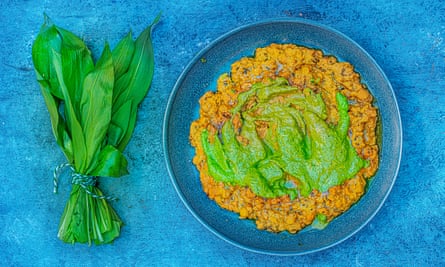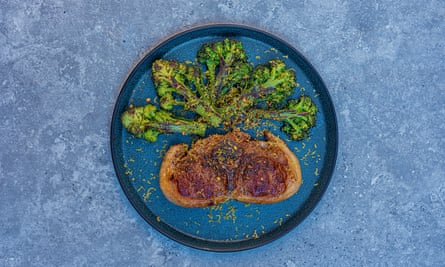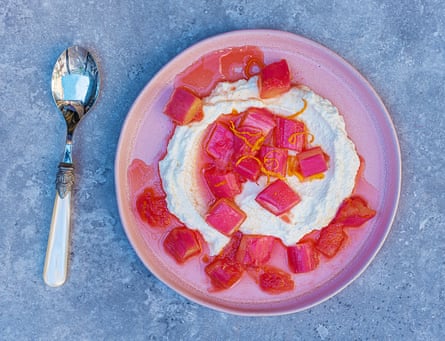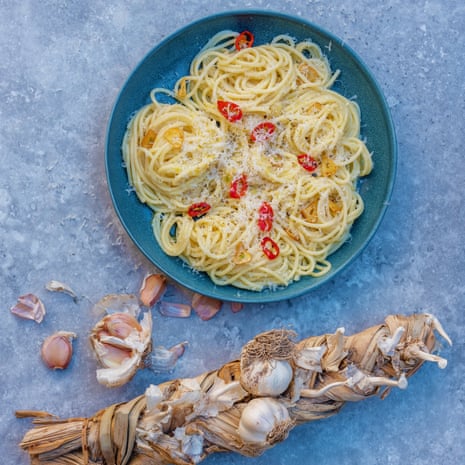Aglio, olio e peperoncino
Giorgio Locatelli
Three ingredients: spaghetti, chilli, parmigiano reggiano
This is one of my favourite dishes. It’s one of the first things you can teach your children to cook – if they are adventurous with strong flavours – and it will stand them in good stead for the rest of their lives, when money is short or cooking for a gang at university or after a late night.
My wife, Plaxy, cooks this for us when we arrive in Puglia on the silly o’clock flight, having been up since 3am. A cold crisp white wine, a bowl of green salad and a plate of aglio olio e peperoncino before a siesta, and all is well with the world.
The spaghetti should be made with Italian grains because the roughness of the surface will catch the oil better. Parmigiano reggiano or grana padano are the two cheeses that work best in this dish (I would recommend a cheese aged for 16-24 months). Always buy cheese in pieces, never buy pre-grated. You can use a variety of chilli, even dried. Some people like the chilli hotter, Plaxy only eats it with habanero – it is really down to your own taste.
Serves 4
spaghetti 500g
chilli 1
garlic 4 cloves
extra virgin olive oil 200ml
parmigiano reggiano or grana padano for serving, grated
Start cooking the spaghetti in plenty of boiling salted water, and slice your chilli (around a tablespoonful, or more if you prefer) and the cloves of garlic about a millimetre thick.
Place a little of the olive oil, cold, in the pan. Put in your garlic, then keep taking the pan off the heat and adding a little more cold oil, then returning it to the heat so that you don’t burn the garlic.
Once all the oil is in, you can let the garlic begin to take on a little bit of colour and put in your chopped chilli. Let it cook very briefly, stirring it into the garlic, then pull the pan from the heat and stir in a couple of spoonfuls of the cooking water from the pasta – take care, as it may spit.
When the pasta is cooked but still al dente, lift it out and drain it, but keep back the cooking water.
Toss the pasta really well through the oil, garlic and chilli, adding a little more cooking water from the pasta if it is too dry, as you want the garlicky hot oil to really cling to the spaghetti, and serve straightaway. Finish with some grated parmesan or grana padano.
Adapted from Made at Home by Giorgio Locatelli
Channa dal with wild garlic puree
Ravinder Bhogal
Three ingredients: wild garlic, lemon, channa dhal

Madhur Jaffrey calls dal “LSD” – life-saving dal – and I quite agree. It is cheap, nutritious, substantial and versatile and can be cooked with myriad ingredients, so it never gets boring. Channa dal is creamy, earthy and, cooked on its own, rather bland, so it lends itself particularly well to the grassy wild garlic we have growing in abundance every spring. If you can’t get hold of wild garlic, use any herbs you have to hand – coriander, parsley, chervil or dill all add a vernal freshness too. I love the subtle flavour of it at the beginning of the season – like garlic without the fangs. Once the lentils have cooked, roughly mash, beat in a little cold butter and a zip of lemon, and finish with the wild garlic puree. You’ll have a pool of something in a bowl that is nothing short of glorious.
Serves 4
For the wild garlic puree
wild garlic 100g, or mixed fresh herbs such as coriander, parsley, chervil or dill
rapeseed oil 6 tbsp
sea salt and pepper
lemon juice of ½ (reserve the other half for the dal)
For the dal
unsalted butter 40g
rapeseed oil 1 tbsp
whole cumin seeds 2 heaped tsp
chilli flakes ½ tsp
garlic 3 fat cloves, finely sliced
lemon zest of 1
channa dal or split yellow peas 250g, washed well
ground turmeric 1 tsp
sea salt and pepper to taste
Begin by making the puree. Roughly chop the wild garlic or fresh herbs. If your wild garlic is flowering and you are feeling fancy, reserve some so you can add a pretty garnish later. Put into a blender along with the rapeseed oil and blitz until you have a smooth puree. Stir in the lemon juice and seasoning. Empty into a bowl and set aside.
Heat 15g of the butter in a large saucepan and add a little oil to stop it burning. Sizzle the cumin and chilli flakes along with the sliced garlic and lemon zest until fragrant. Sprinkle in the turmeric and 1.2 litres of water, along with the channa dal and bring to a boil. At this point you could also add half a tin of tomatoes or some fresh skinned and pureed tomatoes if you like.
Turn the heat to low and then simmer partially covered for around 45 minutes until the lentils are soft and creamy. For speedier cooking, invest in a pressure cooker. I don’t know an Indian housewife who doesn’t own one. If you want it thin and soupy feel free to add more water, but I like mine a little more robust.
Season with salt and pepper and roughly mash. Beat in the remaining butter and squeeze in the juice from the leftover lemon. To serve, dish out into bowls and top with a dollop of wild garlic puree and any reserved flowers. Eat on its own like a soup or serve with rice or hot puffs of chapati. I really enjoy it with a little cheese toastie to dip in it.
Ravinder Bhogal is chef-founder of Jikoni
Crispy chicken thighs, spinach and goat’s cheese
Anna Haugh
Three ingredients: chicken thighs, baby spinach, goat’s cheese

Here is a recipe that is so simple and tasty that you might do the chicken dance with delight. I’m a leg girl – chicken legs and thighs have the best flavour in my opinion, as they are juicy and delicious. The brown meat, as it is referred to, has more flavour than the chicken breast but mysteriously is less popular.
This is healthy fast food – or it’s what fast food should be. Goat’s cheese is easier to digest than cow’s cheese and I love the slightly sour zing you get from a good one: it complements the spinach puree excellently and gives much more depth of flavour to the dish, not to mention the calcium and bundles of other good vitamins. The spinach is packed with vitamin K – trust me, your bones will thank you for this.
Serves 2
cooking oil 1 tsp
chicken thighs 4
salt and pepper to season
butter 20g
salt a good pinch
baby spinach 200g
sugar a pinch
goat’s cheese 80g
Place a frying pan on a medium heat and pour in your cooking oil. Season your chicken thighs with salt and pepper, place in the pan and cook until the skin becomes crispy. This will take around 10 minutes.
While your chicken cooks, in a medium pot, put the butter, a good pinch of salt and most of your spinach (keep a handful to garnish). When the spinach wilts down (this is super quick) pop into a blender and blitz. You might need to add a drop of water to make the puree liquid enough.
Your chicken should almost be done. Check it’s crispy and if it is, flip it onto the other side while you get your plates and cutlery ready. After a minute or two you’re ready to serve.
Serve the spinach puree on the bottom of your plate or bowl, then break your goat’s cheese into chunks. Place the chicken thighs on top, then garnish with some extra spinach leaves and a sprinkle of black pepper.
Anna Haugh is head chef and owner of Myrtle restaurant
Barnsley chop, purple sprouting broccoli and bottarga (or anchovies)
Lee Tiernan
Three ingredients: Barnsley chops, purple sprouting broccoli, bottarga (or anchovies)

Quick, easy, simple and satisfyingly tasty. I’ve always been a fan of surf and turf. Not a huge steak with a few limp prawns skewered and plonked on top but the complex union of flavours between sea and earth. On the surface of things, creatures from the deep aren’t the obvious partner to marry with meat and poultry but think about the multitude of combinations of pork and shrimp, beef and anchovy, cockles and bacon, lamb stew punctuated with seaweed, to name but a few. Salt marsh lamb is prized for its flavour – achieved by its diet of samphire, sea beat and sorrel after grazing close to beaches and estuaries. I prefer Barnsley chops or lamb loin chops as they are generally cut a little thicker than best end chops but both are quick and easy to cook. The garnish goes equally well with braised shoulder or shanks or a roasted leg. This dish can also be easily replicated on the barbecue if you’re so inclined. Bottarga is available online but you can toss some chopped anchovies through the broccoli instead and the dish will be just as delicious.
Serves 4
Barnsley chops (sometimes known as lamb loin chops) 4, preferably with a decent layer of fat
salt and pepper to season
purple sprouting broccoli a good handful per person
bottarga a good thumb-sized piece or
salted anchovies 1 small tin, room temperature
unsalted butter 150g, plus a knob for cooking the chops (around 25g)
chilli flakes 1-2 tsp
sumac 1 tsp
oil for cooking
Take the lamb chops out of the fridge about 40 minutes before you want to cook them. Season the lamb at this point too.
First blanch the broccoli. To do this, bring a pot of water to the boil, season with a pinch of salt and throw in the broccoli. While it is cooking, fill a large bowl with iced water. Boil the broccoli till just tender. Drain it through a colander then shock in a waiting bowl of ice water. If you don’t have any ice to hand, place the bowl of water under a running cold tap for a couple of minutes till the broccoli is cool. Return to the colander to drain for a further few minutes. Ensure it’s as dry as possible, as water will cause the broccoli to spit when it comes into contact with the hot oil. When drained, refrigerate till needed.
To bring the dish together, melt the 150g of butter and keep it in a resting tray. Remove the broccoli from the fridge, making sure it’s as dry as can be. Get your frying pan hot before you cook the chops, especially if you want to achieve decent caramelisation which is where you can really accentuate the flavour of this lamb. When the pan is hot, rub the chops all over with a glug of oil. Carefully lay the chops in the pan - fat-side down - to render some of that lovely fat. If the pan doesn’t make a satisfying sizzle when you put your chops in, it’s not hot enough. When the fat has rendered and each side of the lamb chop has a pleasing golden hue, I like to add a good knob of butter as it helps with the caramelisation I mentioned, but this is optional.
How long your chops take to cook depends on their thickness. Obviously if your chops are on the thin side, a minute or two on either side in a hot pan and a decent warm rest will do it. Thicker chops will take a little longer and you might want to reduce the heat slightly while frying, about 3-4 minutes on each side. Lamb chops are best served medium-rare. You can gauge this by pressing your finger against the eye of meat in the chop. If it is soft it’s probably under. If it’s super firm it’s probably over so aim for somewhere in the middle. Remember you can always cook a chop a bit more to get it to where you want it but you can never uncook something. Rest for a further 5 minutes in the tray of melted butter, and add the chilli flakes.
While the lamb is resting, wipe out the frying pan and get it hot again. Add a glug of oil and chuck in the broccoli. Allow the broccoli to char and blacken in parts. When the broccoli is done, turn off the heat. Place a chop on each plate and add the broccoli to the resting tray. Toss the broccoli with the chilli butter and add the sumac. The citrus properties of sumac will give the dish a nice hit of acidity.
Place the broccoli beside the chop and grate a generous amount of bottarga, or put 3-4 whole anchovy fillets, if using, over the broccoli and a few turns of black pepper from the mill. Serve with a large glass of chilled red or white wine and sharp knives to negotiate the chop with.
Lee Tiernan is chef-owner of Black Axe Mangal
Rhubarb, orange and ricotta
Jeremy Lee
Three ingredients: rhubarb, orange, ricotta

This beautiful trinity is the very spirit of winning simplicity. The pairing of orange and rhubarb is one we adore, the colour and flavour equally beguiling. Made with blood oranges when the rhubarb stems are coloured a deep scarlet, the appearance and flavour become otherworldly, not to mention striking. When the rhubarb is spooned over ricotta beaten with olive oil, the rich savour of the cheese is sweetened by the delightful vanilla-infused orange and rhubarb syrup that forms in the pan when the rhubarb is cooked. Modest and moreish, this makes for an excellent breakfast as well as an elegant pudding for lunch and, of course, dinner.
Serves 6
For the compote
rhubarb 750g
caster sugar 100g
orange 1 small, zest finely grated then juiced
vanilla pod 1, split and scraped
For the ricotta
ricotta 250g
best olive oil 2 dsp
Wash the rhubarb well and dry. Cut the stems into small pieces, roughly 1cm long. Place the rhubarb, sugar, orange zest, juice and scraped vanilla pod in a wide bottomed pan. Cook the rhubarb gently until simmering, then continue to cook, stirring from time to time for 15 minutes or so, until there is very little liquid left at the bottom of the pan. Let cool.
Beat the ricotta with the olive oil, and spoon into a pretty bowl. Tumble the rhubarb over the ricotta with all the deliciousness from the bottom of the pan. Serve!
Jeremy Lee is chef-proprietor at Quo Vadis
The Observer aims to publish recipes for fish rated as sustainable by the Marine Conservation Society’s Good Fish Guide
